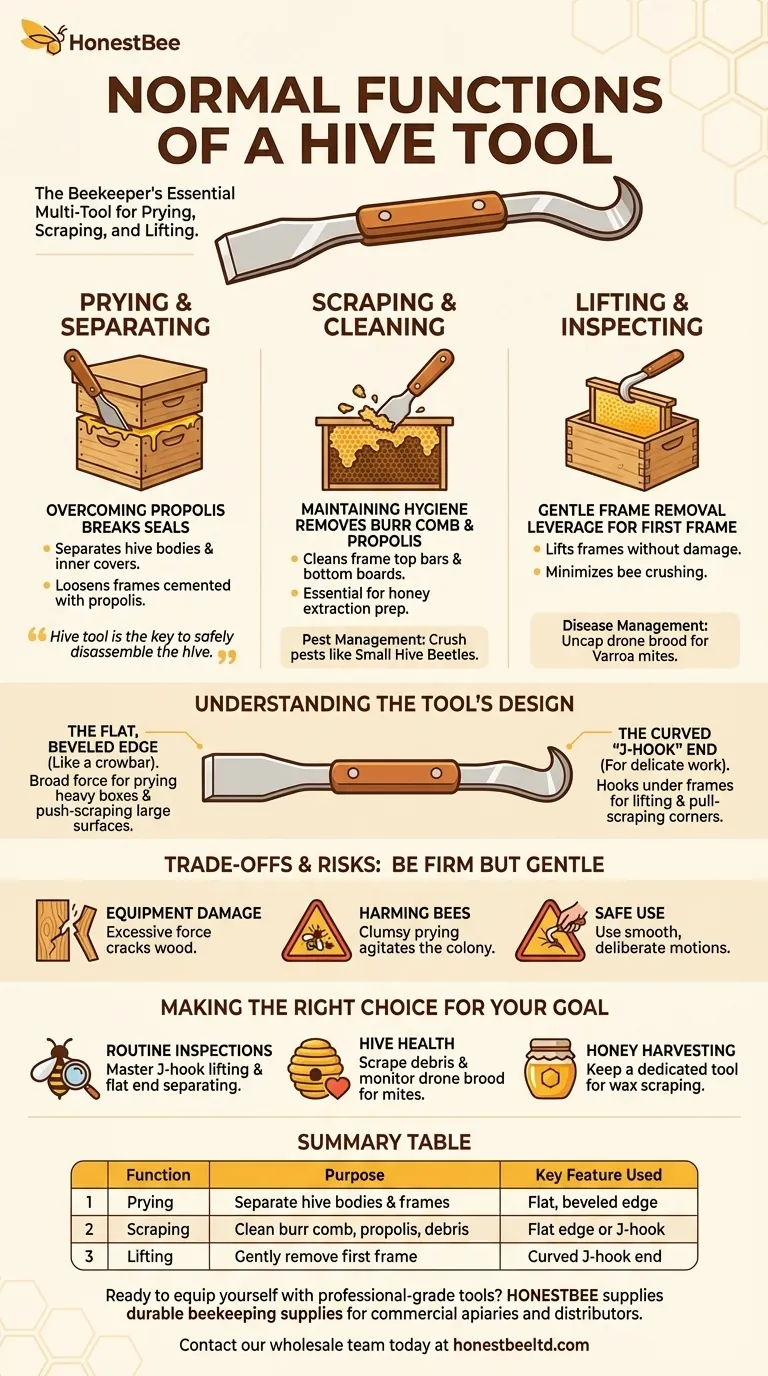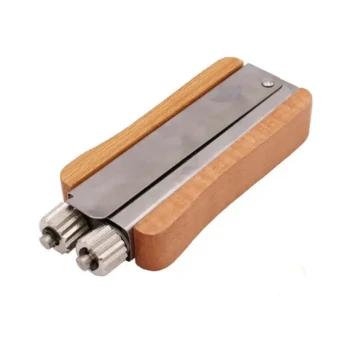At its core, a hive tool is the beekeeper's essential multi-tool, a purpose-built device designed for three primary actions: prying, scraping, and lifting. It is the single most indispensable piece of equipment for interacting with a beehive, allowing a beekeeper to separate hive components sealed with propolis, clean frames and boxes, and inspect the colony with minimal disruption.
A hive tool's true purpose is to overcome the natural defenses and construction of the hive. Bees use a sticky resin called propolis to seal every crack, making the hive a single, solid unit. The hive tool is the key that allows a beekeeper to safely and temporarily disassemble it.

The Essential Functions: Prying and Scraping
The most frequent tasks you will perform with a hive tool revolve around separating stuck components and cleaning the hive. Bees are meticulous builders, but their work makes human inspection impossible without a specialized tool.
Overcoming Propolis and Burr Comb
Bees use propolis, a sticky substance collected from plants, as a glue to seal gaps and reinforce their hive. They also build burr comb (wax comb in undesirable places) to connect frames and boxes.
Your hive tool is the lever needed to break these seals. It is used to pry apart hive bodies (supers), separate the inner cover from the top box, and loosen frames that are cemented together.
Maintaining Hive Hygiene
Scraping is the second pillar of the hive tool's utility. A clean hive is a healthier hive, and the tool's sharp, flat edges are perfect for this task.
Common scraping tasks include removing excess propolis and burr comb from the top bars of frames, cleaning debris from the hive's bottom board, and scraping wax off hive components during honey extraction.
Lifting and Inspecting Frames
The first frame in a hive box is often the most difficult to remove due to the tight fit. A hive tool provides the leverage to gently lift this first frame out without damaging the comb or, more importantly, crushing bees.
One end of the tool is typically curved or L-shaped (a "J-hook"), specifically designed to hook under the top bar of a frame for a secure, controlled lift.
Understanding the Tool's Design
A standard hive tool is not just a simple pry bar; its design is intentional, with each end serving a different purpose.
The Flat, Beveled Edge
This end looks like a small, flat crowbar. Its wide, sharp edge is ideal for tasks requiring broad force.
It is used for prying apart large, heavy hive bodies and for "push-scraping" large, flat surfaces like inner covers or bottom boards.
The Curved "J-Hook" End
The other end has a curve, often at a 90-degree angle. This "J-hook" is designed for more delicate work.
Its primary use is to hook under a frame's end to lift it straight up. It is also an excellent "pull-scraper" for cleaning inside corners or removing a bee stinger from your skin without squeezing the venom sac.
Understanding the Trade-offs and Risks
While essential, improper use of a hive tool can cause more harm than good. The goal is always to be firm but gentle.
Risk of Damaging Equipment
Using excessive force can crack the wooden hive bodies or break the delicate "ears" of a frame's top bar. Always apply steady pressure rather than sudden, jerky movements.
Risk of Harming Bees
A dropped tool or a clumsy pry can crush dozens of bees, releasing alarm pheromone and agitating the colony. Smooth, deliberate motions are critical for keeping the bees calm.
Pest and Disease Management
The hive tool is also a key diagnostic instrument. It can be used to crush pests like Small Hive Beetles on sight.
More importantly, it can be used to uncap a small section of drone brood. This allows you to inspect the developing pupae for the presence of parasitic Varroa mites, one of the most significant threats to honey bee health.
Making the Right Choice for Your Goal
Your proficiency with a hive tool will directly impact the efficiency and calmness of your hive inspections. Focus on mastering its use for your specific needs.
- If your primary focus is routine inspections: Master the art of using the J-hook to lift the first frame and the flat end to gently separate boxes with minimal jarring.
- If your primary focus is hive health: Make a habit of using your tool to scrape the bottom board for debris and to periodically uncap drone brood to monitor for Varroa mites.
- If your primary focus is honey harvesting: Keep a clean, dedicated hive tool for scraping wax from frames before extraction to ensure your honey remains pure.
Ultimately, mastering the hive tool is the first step toward becoming a confident and effective beekeeper.
Summary Table:
| Function | Purpose | Key Feature Used |
|---|---|---|
| Prying | Separate hive bodies & frames sealed with propolis | Flat, beveled edge |
| Scraping | Clean burr comb, propolis, and debris | Flat edge or J-hook |
| Lifting | Gently remove the first frame from a box | Curved J-hook end |
Ready to equip yourself with professional-grade tools?
A high-quality hive tool is the foundation of efficient and safe beekeeping. At HONESTBEE, we supply durable beekeeping supplies and equipment designed for the demands of commercial apiaries and distributors.
Upgrade your operation with tools built for professionals. Contact our wholesale team today to discuss your needs and discover how our equipment can support your success.
Visual Guide

Related Products
- HONESTBEE Premium Italian Style Hive Tool with Hardwood Handle
- HONESTBEE Professional Long Handled Hive Tool with Precision Cutting Blade
- Professional Dual-End Stainless Steel Hive Tool for Beekeeping
- HONESTBEE Advanced Ergonomic Stainless Steel Hive Tool for Beekeeping
- Professional Multi-Function Stainless Steel Hive Tool
People Also Ask
- Is it advisable to manage a large number of hives alone? The Risks of Solo Beekeeping at Scale
- What is required for regular inspections in both Flow Hives and Langstroth hives? Essential Beekeeping Tasks Explained
- How should beekeepers handle bees when using a hive tool? Master Calm, Deliberate Techniques
- What are the benefits of a multi-functional hive tool? Streamline Your Apiary Workflow with One Tool
- What maintenance steps are recommended for hive tools? Ensure Longevity & Apiary Health



















